Coburn J.W. Algebra and Trigonometry
Подождите немного. Документ загружается.

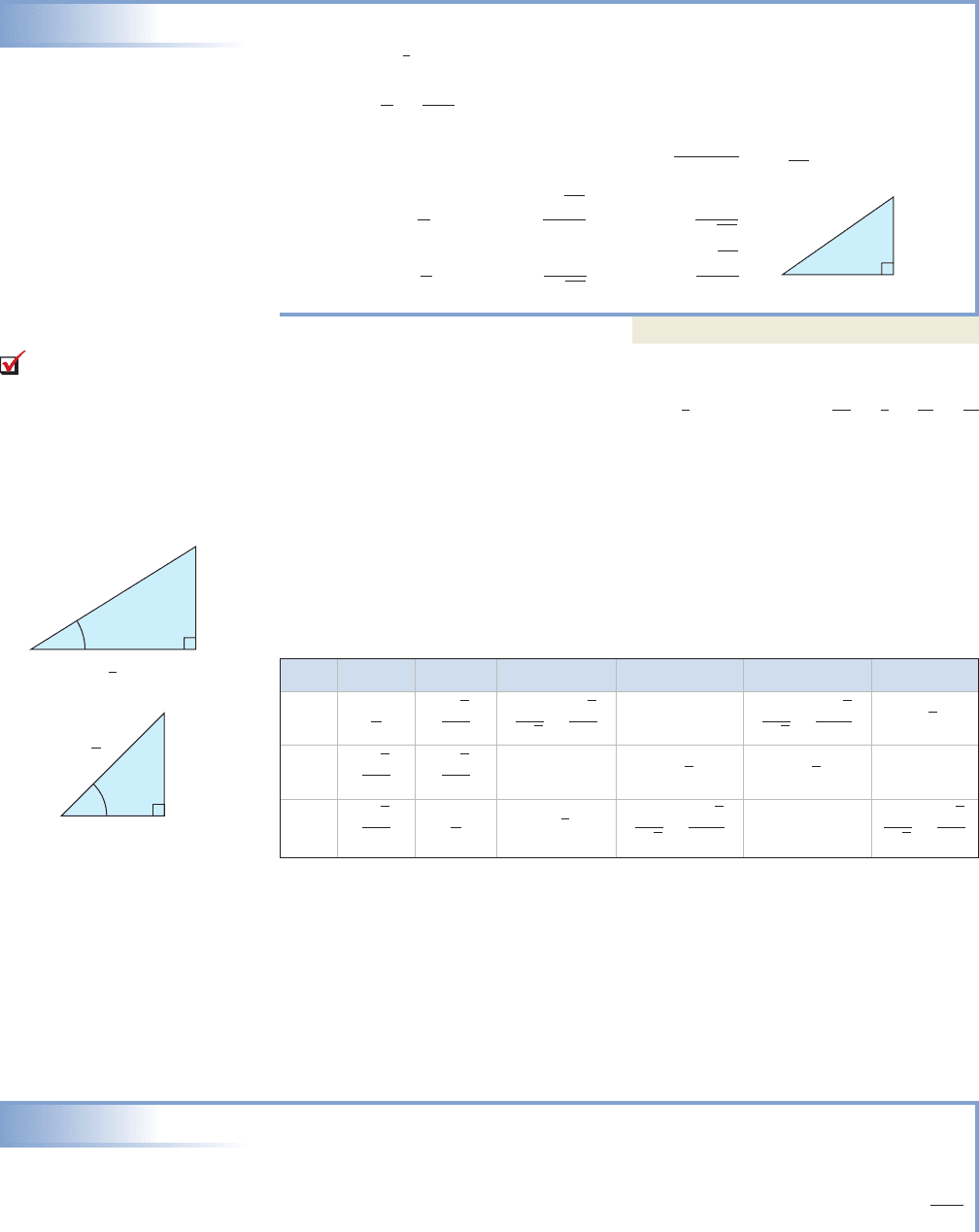
520 CHAPTER 5 An Introduction to Trigonometric Functions 5-18
Now that these ratios have been formally named, we can state values of all six
functions given sufficient information about a right triangle.
EXAMPLE 1
Finding Function Values Using a Right Triangle
Given find the values of the remaining trig functions.
Solution
For we draw a triangle with a side of 4 units opposite a designated
angle , and label a hypotenuse of 7 (see the figure). Using the Pythagorean theorem
we find the length of the adjacent side: The ratios are
Now try Exercises 7 through 12
Note that due to the properties of similar triangles, identical results would be
obtained using any ratio of sides that is equal to In other words,
and so on, will all give the same value for .
B. Solving Right Triangles Given One Angle and One Side
Example 1 gave values of the trig functions for an unknown angle . Using the special tri-
angles, we can state the value of each trig function for and based on the
related ratio (see Table 5.1). These values are used extensively in a study of trigonometry
and must be committed to memory.
To solve a right triangle means to find the measure of all three angles and all
three sides. This is accomplished using combinations of the Pythagorean theorem,
the properties of triangles, and the trigonometric ratios. We will adopt the conven-
tion of naming each angle with a capital letter at the vertex or using a Greek letter
on the interior. Each side is labeled using the related lowercase letter from the angle
opposite. The complete solution should be organized in table form as in Example 2.
Note the quantities shown in bold were given, and the remaining values were found
using the techniques mentioned.
EXAMPLE 2
Solving a Right Triangle
Solve the triangle shown below.
Solution
Applying the sine ratio (since the side opposite is given), we have: .sin 30°
opp
hyp
30°
60°30°, 45°,
sin
2
3.5
4
7
8
14
16
28
4
7
.
csc
7
4
sec
7
133
cot
133
4
sin
4
7
cos
133
7
tan
4
133
adj 27
2
4
2
133.
sin
4
7
opp
hyp
,
sin
4
7
,
4
ad
j
7
A. You’ve just learned
how to find values of the six
trigonometric functions from
their ratio definitions
Table 5.1
2
11
2
1
13
13
3
2
13
213
3
13
1
2
13
2
60°
1212
12
2
12
2
45°
13
2
13
213
3
1
13
13
3
13
2
1
2
30°
cot sec csc tan cos sin
opp
x
adj
√3x
hyp
2x
30
60
opp
x
hyp
√
2x
45
45
adj
x
College Algebra & Trignometry—
cob19529_ch05_503-614.qxd 12/27/08 10:33 Page 520
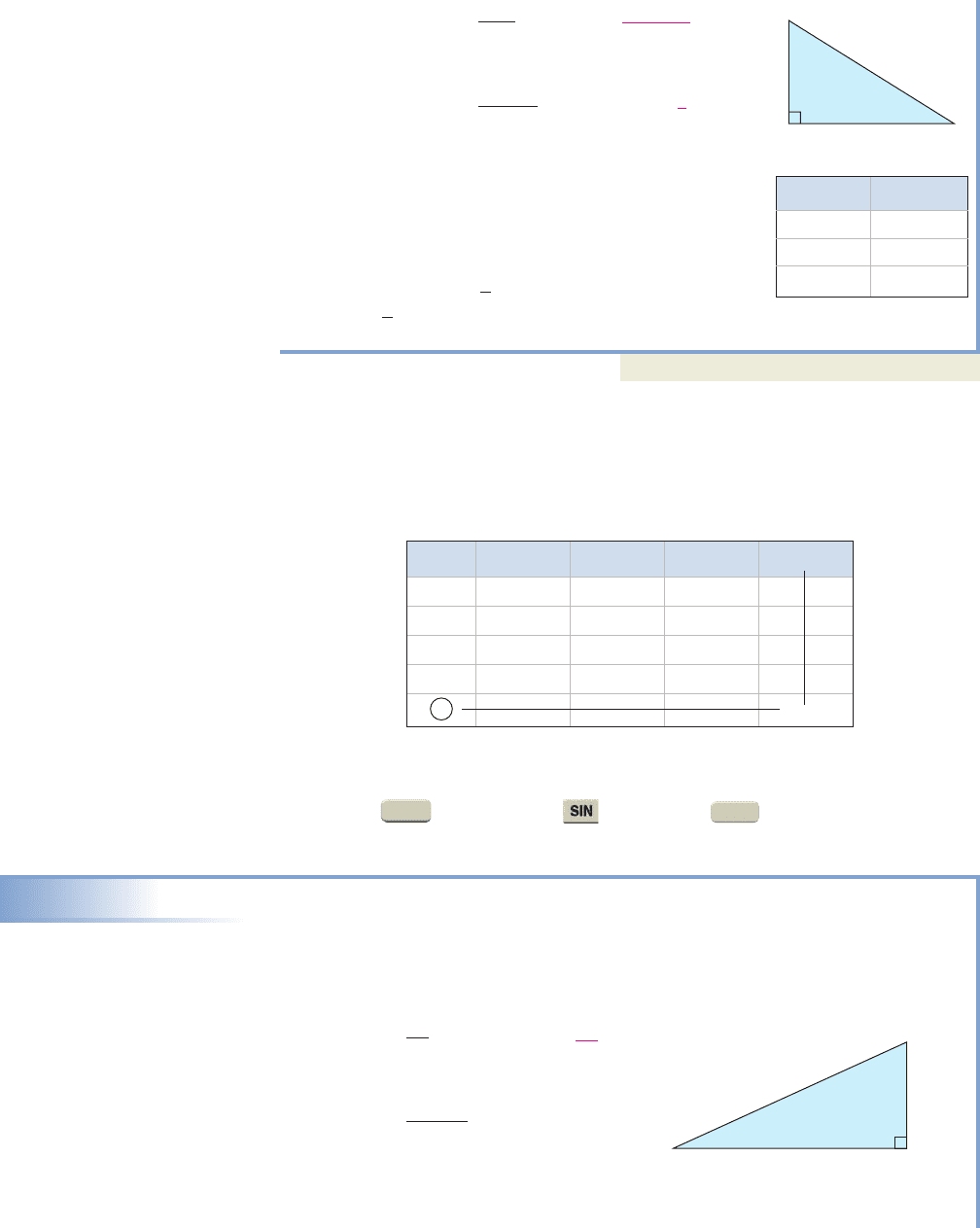
5-19 Section 5.2 The Trignometry of Right Triangles 521
For side c:
multiply by c
divide by
result
Using the Pythagorean theorem shows and
since and are complements, Note
the results would have been identical if the special
ratios from the 30-60-90 triangle were applied. The
hypotenuse is twice the shorter side:
and the longer side is times the shorter:
Now try Exercises 13 through 16
Prior to the widespread availability of handheld calculators, a table of values was
used to find , and for nonstandard angles. Table 5.2 shows the sine of
is approximately 0.7604.
Today these trig values are programmed into your calculator and we can retrieve them
with the push of a button (or two). To find the sine of , make sure your calculator
is in degree , then press the key, 48, and . The result should be very
close to 0.7431 as the table indicates.
EXAMPLE 3
Solving a Right Triangle
Solve the triangle shown in the figure.
Solution
We know since We can find length b using the tangent
function:
multiply by b
divide by
result
We can find the length c by simply applying the Pythagorean theorem, or by using
another trig ratio and a known angle.
38.41 mm
tan 32° b
24
tan 32°
b tan 32° 24
tan 32°
opp
adj
tan 32°
24
b
A B 90°.B 58°
ENTER
MODE
48°
49° 30¿
tan cos sin ,
b 17.9113
2 31.
13
c 2117.92 35.8,
B 60°.
BA
b 31,
35.8
sin 30°
1
2
c
17.9
sin 30°
c sin 30° 17.9
sin 30°
opposite
hypotenuse
sin 30°
17.9
c
c
17.9
30
B
CA
b
Table 5.2
sin
0.7071 0.7092 0.7112 0.7133
46 0.7193 0.7214 0.7234 0.7254
47 0.7314 0.7333 0.7353 0.7373
48 0.7431 0.7451 0.7470 0.7490
49 0.7547 0.7566 0.7585 0.7604
45
3020100
"
"
c
b
24 mm
32
A
C
B
College Algebra & Trignometry—
Angles Sides
c 35.8
C 90
b 31B 60°
a 17.9
A 30
cob19529_ch05_503-614.qxd 11/11/08 1:45 PM Page 521 epg HD 049:Desktop Folder:Coburn_do_t del-ch05:
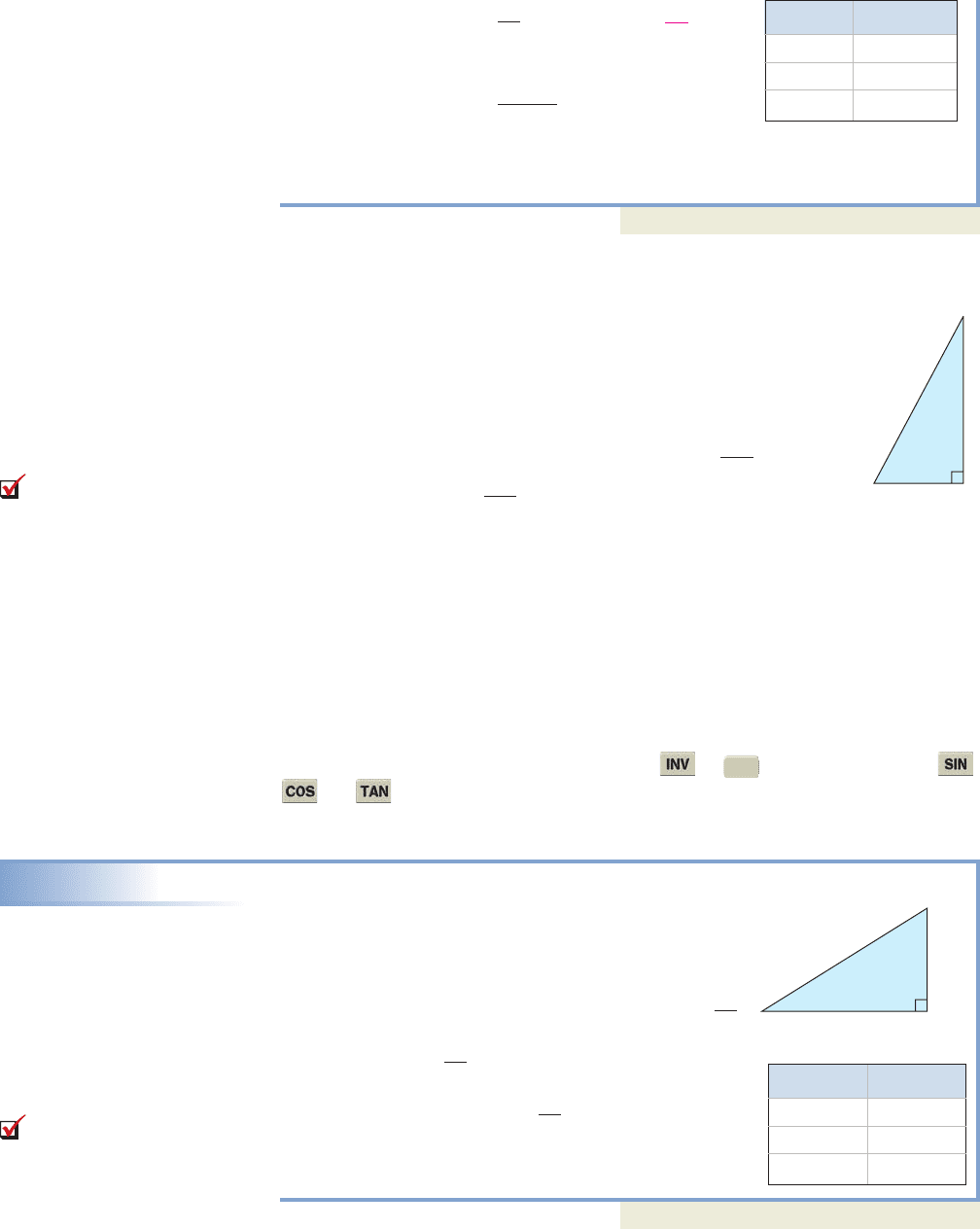
522 CHAPTER 5 An Introduction to Trigonometric Functions 5-20
For side c:
multiply by c
divide by
result
The complete solution is shown in the table.
Now try Exercises 17 through 22
When solving a right triangle, any of the triangle relationships
can be employed: (1) angles must sum to (2) Pythagorean
theorem, (3) special triangles, and (4) the trigonometric functions of
an acute angle. However, the resulting equation must have only one
unknown or it cannot be used. For the triangle shown in Figure 5.18,
we cannot begin with the Pythagorean theorem since sides a and b
are unknown, and is unusable for the same reason. Since the
hypotenuse is given, we could begin with and solve
for b, or with and solve for a, then work out a com-
plete solution. Verify that and .
C. Solving Right Triangles Given Two Sides
The partial table for given earlier was also used in times past to find an angle
whose sine was known, meaning if then must be (see the last
line of Table 5.2). The modern notation for “an angle whose sine is known” is
or where x is the known value for The values for the
acute angles and are also programmed into your
calculator and are generally accessed using the or keys with the related ,
, or key. With these we are completely equip to find all six measures of a
right triangle, given at least one side and any two other measures.
EXAMPLE 4
Solving a Right Triangle
Solve the triangle given in the figure.
Solution
Since the hypotenuse is unknown, we cannot begin with
the sine or cosine ratios. The opposite and adjacent
sides for are known, so we use For
we find [verify that
. Since and are
complements, The Pythagorean
theorem shows the hypotenuse is about 30.23 m.
Now try Exercises 23 through 54
90 34.2 55.8°.
tan134.2°2 0.6795992982
17
25
4
tan
1
a
17
25
b 34.2°
tan
17
25
tan .
2nd
tan
1
x cos
1
x, sin
1
x,
sin . arcsin x, sin
1
x
49.5°sin 0.7604,
sin
b 95.66 fta 118.13 ft
sin 51°
a
152
cos 51°
b
152
tan 51°
180°,
45.29 mm
sin 32° c
24
sin 32°
c sin 32° 24
sin 32°
opp
hyp
sin 32°
24
c
a
152 ft
51
B
AC
b
Figure 5.18
B. You’ve just learned how
to solve a right triangle given
one angle and one side
C. You’ve just learned how
to solve a right triangle given
two sides
c
25 m
17 m
College Algebra & Trignometry—
Angles Sides
c 45.29
C 90
b 38.41B 58°
a 24
A 32
Angles Sides
c 30.23
90
b 25
55.8°
a 17
34.2°
cob19529_ch05_503-614.qxd 11/11/08 1:45 PM Page 522 epg HD 049:Desktop Folder:Coburn_do_t del-ch05:
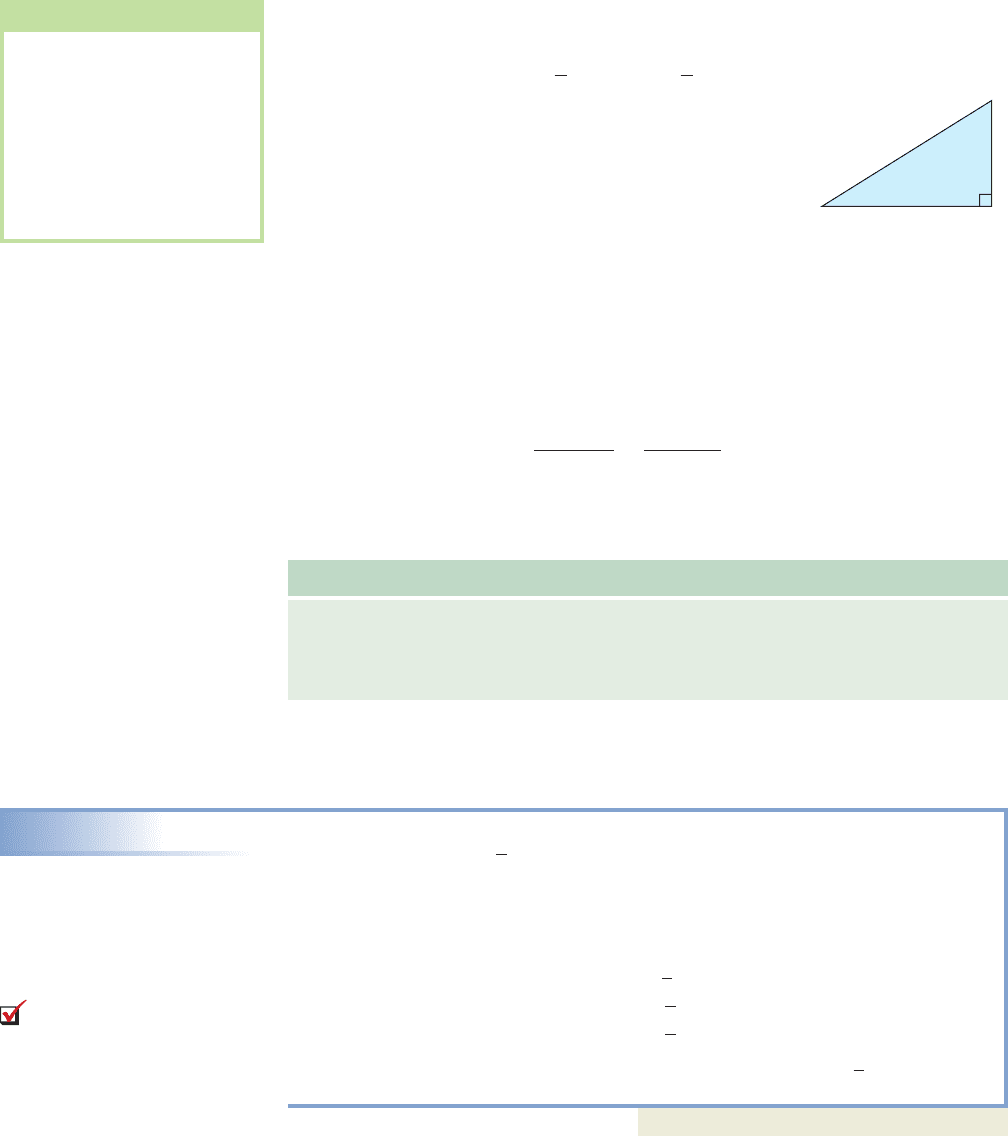
5-21 Section 5.2 The Trignometry of Right Triangles 523
D. Using Cofunctions and Complements
to Write Equivalent Expressions
In Figure 5.19, and must be complements since we have a right triangle,
and the sum of the three angles must be The complementary angles in a right
triangle have a unique relationship that is often used. Specifically means
. Note that and This means
or by substitution.
In words, “The sine of an angle is equal to the cosine of its
complement.” For this reason sine and cosine are called
cofunctions(hence the name cosine), as are secant/cosecant,
and tangent/cotangent. As a test, we use a calculator to check
the statement
✓
To verify the cofunction relationship for sec and csc , recall their reciprocal rela-
tionship to cosine and sine, respectively.
✓
The cofunction relationship for tan and cot can similarly be verified.
Summary of Cofunctions
sine and cosine tangent and cotangent secant and cosecant
For use in Example 5 and elsewhere in the text, note the expression is
simply a more convenient way of writing
EXAMPLE 5
Applying the Cofunction Relationship
Given in exact form, find the exact value of using a
cofunction. Check the result using a calculator.
Solution
Using gives
cofunctions
substitute known value
square as indicated
result
Using a calculator, we verify
Now try Exercises 55 through 68
tan
2
15° 0.0717967697 7 413.
7 413
4 413 3
12 13
2
2
cot
2
75° tan
2
15°
cot 75° tan190° 75°2 tan 15°
tan
2
15°cot 75° 2 13
1tan 15°2
2
.
tan
2
15°
csc sec190 2cot tan190 2cos sin190 2
sec csc190 2tan cot190 2sin cos190 2
1.635250666 1.635250666
1
cos 52.3°
1
sin 37.7°
sec 52.3° csc 37.7°
0.791223533 0.791223533
sin 52.3° cos 37.7°
sin 52.3° cos190 52.32°
sin cos190° 2sin cos
cos
a
c
.sin
a
c
90°
90°
180°.
Figure 5.19
D. You’ve just learned
how to use cofunctions and
complements to write
equivalent expressions
b
c
a
WORTHY OF NOTE
The word cosine is actually a
shortened form of the words
“complement of sine,” a
designation suggested by
Edmund Gunter around
1620 since the sine of an
angle is equal to the
cosine of its complement
.
3sine12 cosine190° 24
College Algebra & Trignometry—
cob19529_ch05_503-614.qxd 11/11/08 1:45 PM Page 523 epg HD 049:Desktop Folder:Coburn_do_t del-ch05:
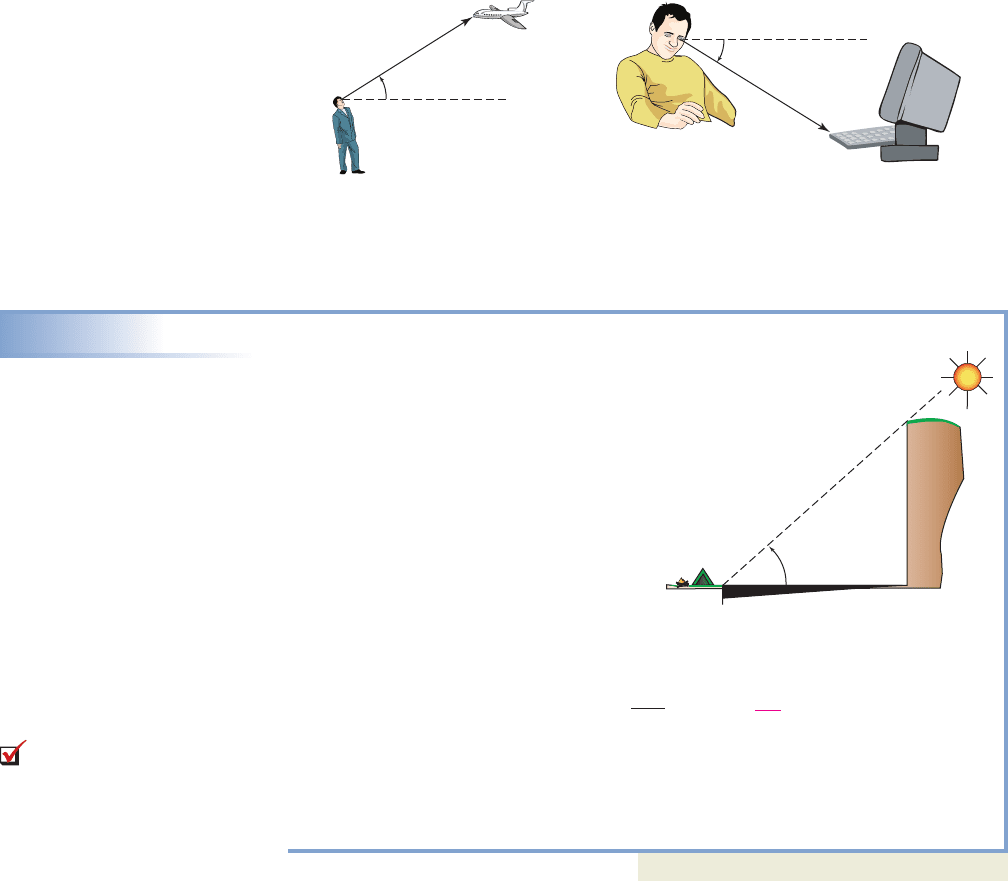
524 CHAPTER 5 An Introduction to Trigonometric Functions 5-22
E. Applications Using Angles of Elevation/Depression
While the name seems self-descriptive, in more formal terms an angle of elevation is
defined to be the acute angle formed by a horizontal line of orientation (parallel to
level ground) and the line of sight (see Figure 5.20). An angle of depression is like-
wise defined but involves a line of sight that is below the horizontal line of orientation
(Figure 5.21).
Angles of elevation/depression make distance and length computations of all sizes
a relatively easy matter and are extensively used by surveyors, engineers, astronomers,
and even the casual observer who is familiar with the basics of trigonometry.
EXAMPLE 6
Applying Angles of Elevation
In Example 4 from Section 5.1, a group
of campers used a 45-45-90 triangle to
estimate the height of a cliff. It was a
time consuming process as they had to
wait until mid-morning for the shadow of
the cliff to make the needed angle. If
the campsite was 250 yd from the base of
the cliff and the angle of elevation was
at that point, how tall is the cliff?
Solution
As described we want to know the height
of the opposite side, given the adjacent
side, so we use the tangent function.
For height h:
multiply by 250
result
The cliff is approximately 209.8 yd high (about 629 ft).
Now try Exercises 71 through 76
F. Additional Applications of Right Triangles
In their widest and most beneficial use, the trig functions of acute angles are used
with other problem-solving skills, such as drawing a diagram, labeling unknowns,
working the solution out in stages, and so on. Example 7 serves to illustrate some of
these combinations.
1tan 40° 0.83912 209.8 h
250 tan 40° h
tan 40°
opp
adj
tan 40°
h
250
40°
45°
S angle of depression
Line of orientation
Line of sight
S angle of elevation
Line of orientation
Line of sight
Figure 5.20
Figure 5.21
E. You’ve just learned how
to solve applications involving
angles of elevation and
depression
h
40
250 yd
Angle of elevation
College Algebra & Trignometry—
cob19529_ch05_503-614.qxd 12/27/08 10:34 Page 524
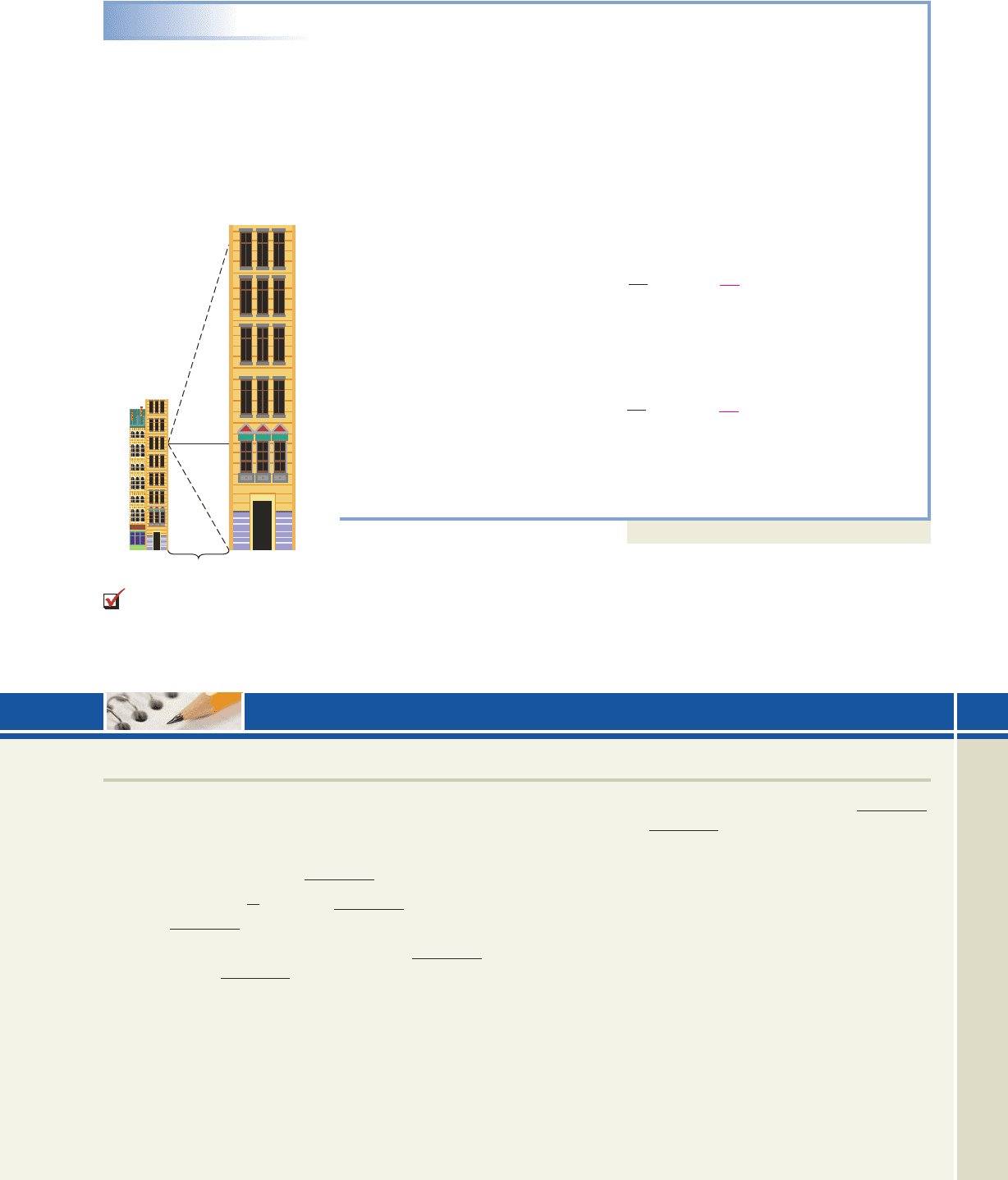
5-23 Section 5.2 The Trignometry of Right Triangles 525
EXAMPLE 7
Applying Angles of Elevation and Depression
From his hotel room window on the sixth floor, Singh notices some window
washers high above him on the hotel across the street. Curious as to their height
above ground, he quickly estimates the buildings are 50 ft apart, the angle of
elevation to the workers is about , and the angle of depression to the base of the
hotel is about .
a. How high above ground is the window of Singh’s hotel room?
b. How high above ground are the workers?
Solution
a. Begin by drawing a diagram of the situation (see figure). To find the height of
the window we’ll use the tangent ratio, since the adjacent side of the angle is
known, and the opposite side is the height we desire.
For the height h
1
:
solve for h
1
result
The window is approximately 59.6 ft above ground.
b. For the height h
2
:
solve for h
2
result
The workers are approximately ft above ground.
Now try Exercises 77 through 80
There are a number of additional, interesting applications in the exercise set.
283.6 59.6 343.2
1tan 80° 5.67132 283.6 h
2
50 tan 80° h
2
tan 80°
opp
adj
tan 80°
h
2
50
1tan 50° 1.19182 59.6 h
1
50 tan 50° h
1
tan 50°
opp
adj
tan 50°
h
1
50
50°
80°
x
50 ft
80°
50°
(not to scale)
h
1
h
2
5.2 EXERCISES
Fill in each blank with the appropriate word or phrase.
Carefully reread the section if needed.
1. The phrase, “an angle whose tangent is known,” is
written notationally as .
2. Given because they
are .
3. The sine of an angle is the ratio of the
side to the .
sin
7
24
, csc
4. The cosine of an angle is the ratio of the
side to the .
5. Discuss/Explain exactly what is meant when you
are asked to “solve a triangle.” Include an
illustrative example.
6. Given an acute angle and the length of the adjacent
leg, which four (of the six) trig functions could be
used to begin solving the triangle?
CONCEPTS AND VOCABULARY
College Algebra & Trignometry—
F. You’ve just learned how
to solve general applications
of right triangles
cob19529_ch05_503-614.qxd 12/27/08 10:34 Page 525
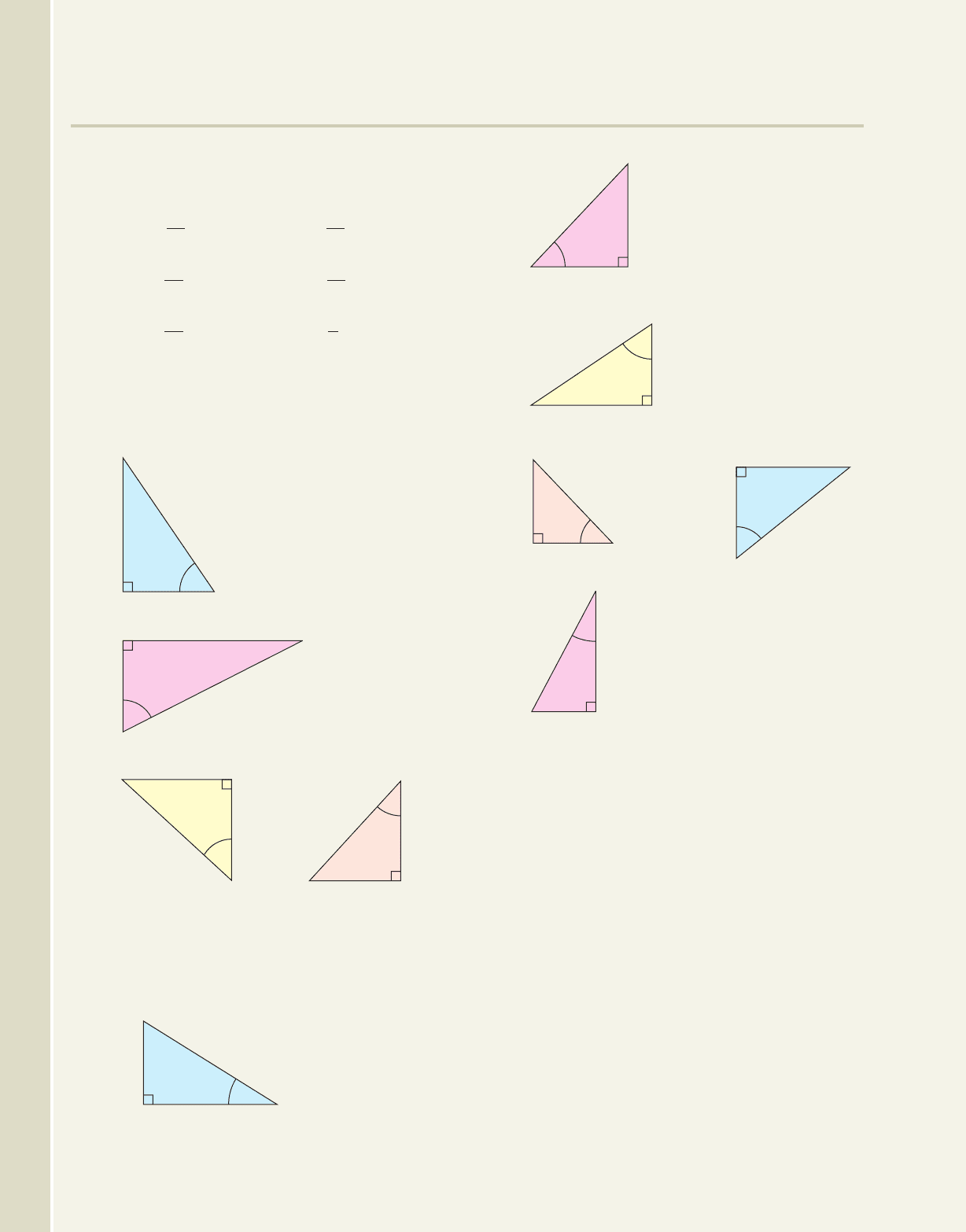
DEVELOPING YOUR SKILLS
526 CHAPTER 5 An Introduction to Trigonometric Functions 5-24
Use the function value given to determine the value of
the other five trig functions of the acute angle . Answer
in exact form (a diagram will help).
7. 8.
9. 10.
11. 12.
Solve each triangle using trig functions of an acute
angle . Give a complete answer (in table form) using
exact values.
13.
14.
15. 16.
Solve the triangles shown and write answers in table
form. Round sides to the nearest 100th of a unit. Verify
that angles sum to and that the three sides satisfy
(approximately) the Pythagorean theorem.
17.
c
14 m
22
B
C
A
b
180
ac
A
C
B
81.9 m
45
c
a
B
A
C
9.9 mm
45
c
b
A
C
B
420 ft
60
a
b
CA
B
196 cm
30
cos
2
3
cot
2
11
sec
53
45
tan
84
13
sin
20
29
cos
5
13
18.
19.
20. 21.
22.
Use a calculator to find the value of each expression,
rounded to four decimal places.
23. 24.
25. 26.
27. 28.
29. 30.
Use a calculator to find the acute angle whose
corresponding ratio is given. Round to the nearest 10th
of a degree. For Exercises 31 through 38, use Exercises
23 through 30 to answer.
31. 32.
33. 34.
35. 36.
37. 38.
39. 40.
41. 42. tan 3.1336sin 0.3453
cos 0.7408tan 0.9896
tan B 9.6768sin A 0.9063
csc 1.5890sec B 1.3230
cot A 0.6420tan 0.8391
cos B 0.3090sin A 0.4540
tan 84.1°sin 65°
csc 39°sec 40.9°
cot 57.3°tan 40°
cos 72°sin 27°
ac
A
C
B
45.8 m
28
c
b
A
C
B
625 mm
65
238 ft
51
B
CA
b
a
c
5.6 mi
58
B
AC
b
c
89 in.
49
B
A
C
b
College Algebra & Trignometry—
cob19529_ch05_503-614.qxd 11/11/08 1:45 PM Page 526 epg HD 049:Desktop Folder:Coburn_do_t del-ch05:
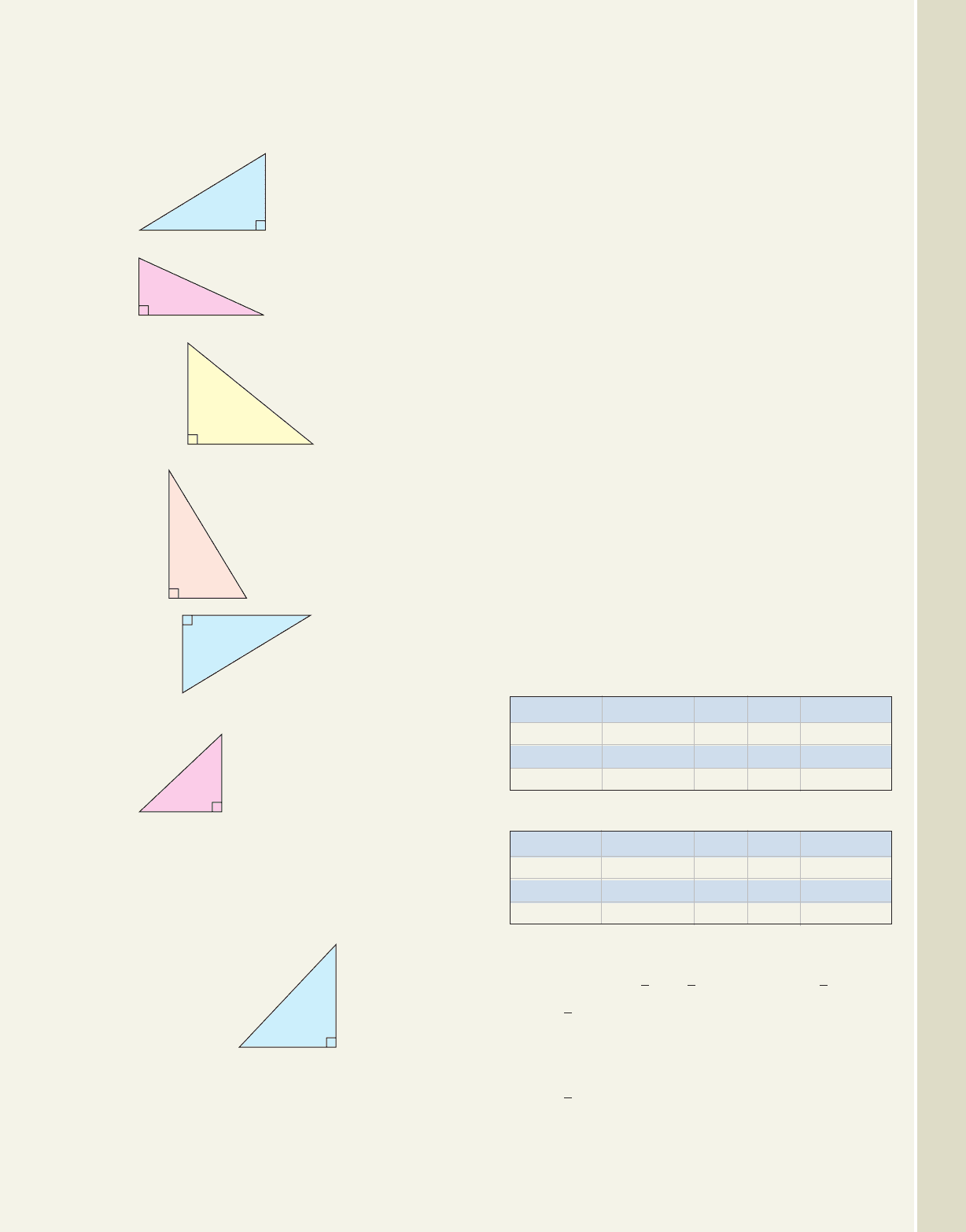
Select an appropriate function to find the angle
indicated (round to 10ths of a degree).
43.
44.
45.
46.
47.
48.
Draw a right triangle ABC as shown, using the
information given. Then select an appropriate ratio to
find the side indicated. Round to the nearest 100th.
49. 50.
find side a find side c
b 31 ftc 52 mm
B 55°A 25°
ca
B
A
C
b
207 yd
221 yd
A
B
20 mm
42 mm
A
5 mi 6.2 mi
19.5 cm
18.7 cm
14 in.
15 in.
6 m
18 m
5-25 Section 5.2 The Trignometry of Right Triangles 527
Exercises 49 to 54
51. 52.
find side b find side a
53. 54.
find side c find side b
Use a calculator to evaluate each pair of functions and
comment on what you notice.
55.
56.
57.
58.
Based on your observations in Exercises 55 to 58, fill in
the blank so that the functions given are equal.
59. cos ___
60. cos ___,
61. tan ___
62. sec ___
Complete the following tables without referring to the
text or using a calculator.
63.
64.
Evaluate the following expressions without a calculator,
using the cofunction relationship and the following exact
forms:
65.
66.
67.
68. 13
cot 15°
cot
2
15°
csc
2
15°
16
csc 15°
sec 7516 12; tan 752 13.
cot sec csc tan190 2cos190 2
45°
sin190 2tan cos sin
cot sec csc tan190 2cos190 2
30°
sin190 2tan cos sin
csc 17°,
cot 69°,
sin 12°
sin 47°,
sec 40°, csc 50°
tan 5°, cot 85°
sin 57°, cos 33°
sin 25°, cos 65°
a 32.8 kmb 82.5 furlongs
B 12.5°A 62.3°
c 9.5 yda 1.9 mi
B 29.6°A 32°
College Algebra & Trignometry—
cob19529_ch05_503-614.qxd 11/11/08 1:45 PM Page 527 epg HD 049:Desktop Folder:Coburn_do_t del-ch05:
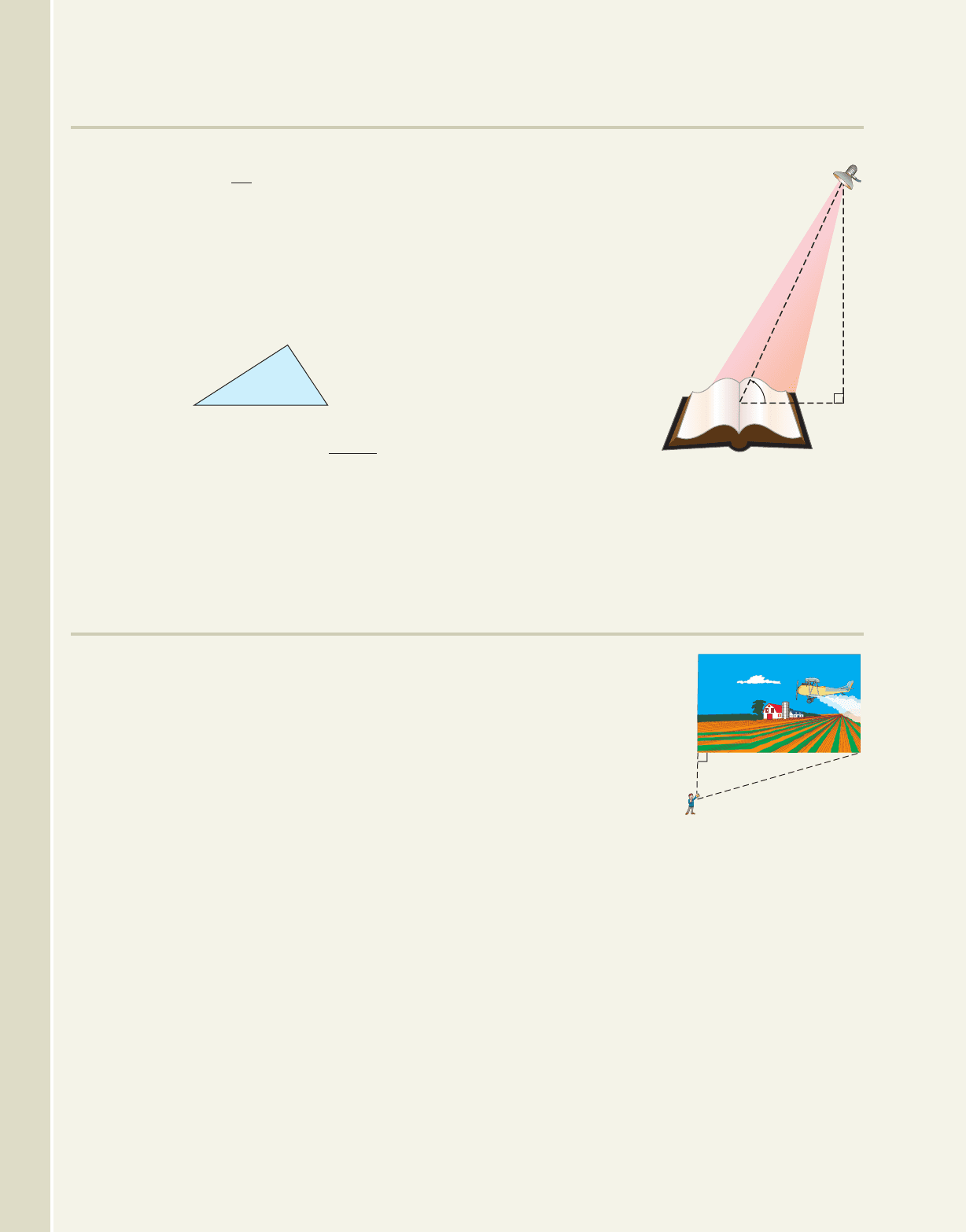
WORKING WITH FORMULAS
where d is the distance from the
light source (in feet), I is the
intensity of the light [in
candelas (cd)], and is the
angle the light source makes
with the vertical. For reading
a book, an illumination E of
at least 18 lm/ft
2
is
recommended. Assuming the
open book is lying on a
horizontal surface, how
far away should a
light source be
placed if it has an
intensity of 90 cd
(about 75 W) and the
light flux makes an
angle of with the book’s surface
(i.e., )? 25°
65°
528 CHAPTER 5 An Introduction to Trigonometric Functions 5-26
69. The sine of an angle between two sides of a
triangle:
If the area A and two sides a and b of a triangle are
known, the sine of the angle between the two sides
is given by the formula shown. Find the angle for
the triangle below given
units
2
, and use it
to solve the triangle. (Hint:Apply the same
concept to angle or .)
70. Illumination of a surface:
The illumination E of a surface by a light source is
a measure of the luminous flux per unit area that
reaches the surface. The value of E [in lumens (lm)
per square foot] is given by the formula shown,
E
I cos
d
2
24
8
17
A 38.9
sin
2A
ab
APPLICATIONS
71. Angle of elevation: For a person standing 100 m
from the center of the base of the Eiffel Tower, the
angle of elevation to the top of the tower is .
How tall is the Eiffel Tower?
72. Angle of depression: A person standing near the
top of the Eiffel Tower notices a car wreck some
distance from the tower. If the angle of depression
from the person’s eyes to the wreck is , how far
away is the accident from the base of the tower?
See Exercise 71.
73. Angle of elevation: In 2001, the tallest building in
the world was the Petronas Tower I in Kuala
Lumpur, Malaysia. For a person standing 25.9 ft
from the base of the tower, the angle of elevation to
the top of the tower is . How tall is the Petronas
tower?
74. Angle of depression: A person standing on
the top of the Petronas Tower I looks out across
the city and pinpoints her residence. If the angle
of depression from the person’s eyes to her home
is , how far away (in feet and in miles) is
the residence from the base of the tower? See
Exercise 73.
75. Crop duster’s speed: While standing near the
edge of a farmer’s field, Johnny watches a crop
5°
89°
32°
71.6°
duster dust the
farmer’s field for
insect control.
Curious as to the
plane’s speed during
each drop, Johnny
attempts an estimate
using the angle of
rotation from one end
of the field to the
other, while standing 50 ft from one corner. Using
a stopwatch he finds the plane makes each pass in
2.35 sec. If the angle of rotation was , how fast
(in miles per hour) is the plane flying as it applies
the insecticide?
76. Train speed: While driving to their next gig,
Josh and the boys get stuck in a line of cars at a
railroad crossing as the gates go down. As the
sleek, speedy express train approaches, Josh
decides to pass the time estimating its speed. He
spots a large oak tree beside the track some
distance away, and figures the angle of rotation
from the crossing to the tree is about . If their
car is 60 ft from the crossing and it takes the train
3 sec to reach the tree, how fast is the train moving
in miles per hour?
80°
83°
50 ft
65°
90 cd (about 75 W)
College Algebra & Trignometry—
cob19529_ch05_503-614.qxd 12/27/08 10:34 Page 528
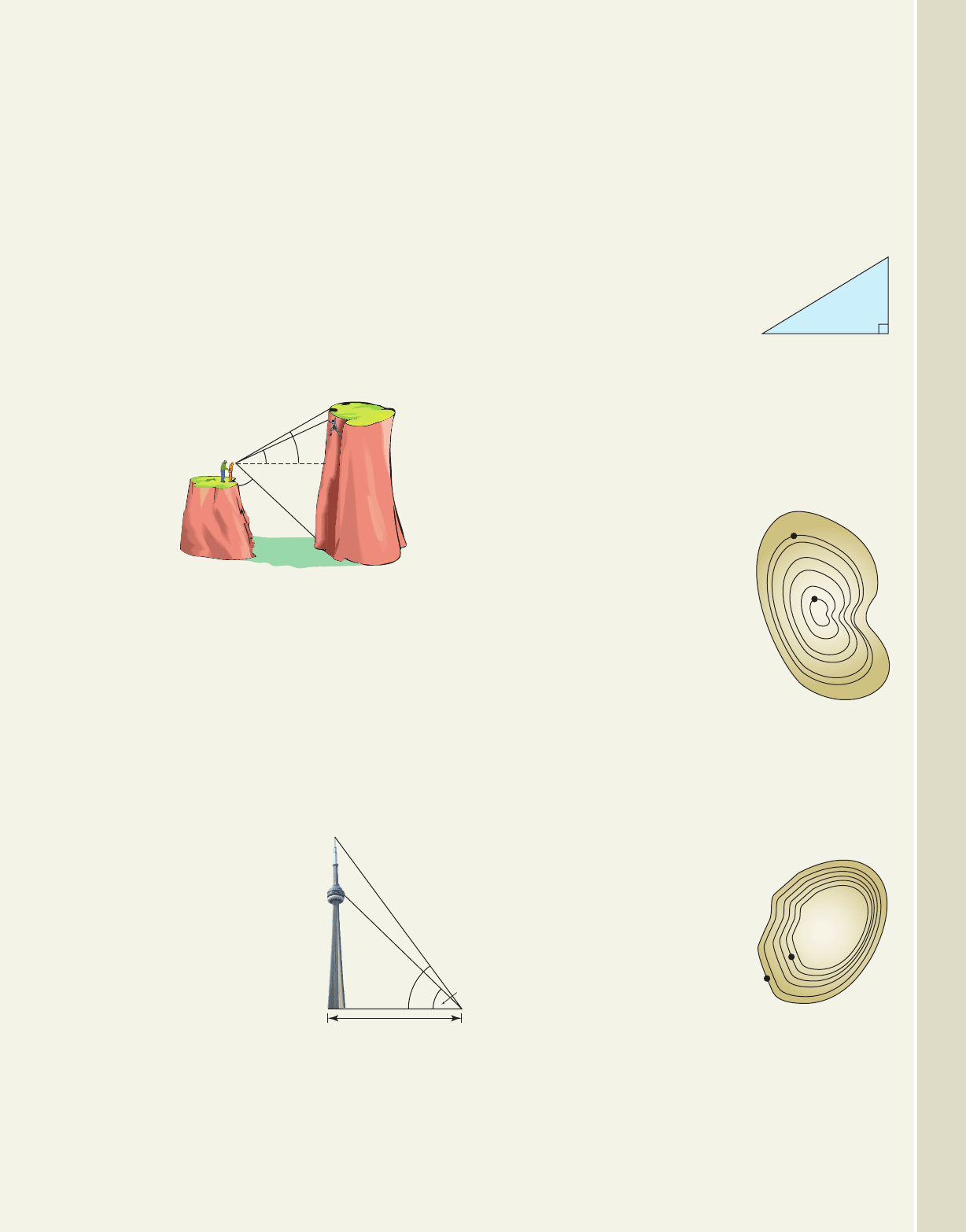
77. Height of a climber: A local Outdoors Club has
just hiked to the south rim of a large canyon, when
they spot a climber attempting to scale the taller
northern face. Knowing the distance between the
sheer walls of the northern and southern faces of the
canyon is approximately 175 yd, they attempt to
compute the distance remaining for the climbers to
reach the top of the northern rim. Using a
homemade transit, they sight an angle of depression
of to the bottom of the north face, and angles of
elevation of and to the climbers and top of
the northern rim respectively. (a) How high is the
southern rim of the canyon? (b) How high is the
northern rim? (c) How much farther until the
climber reaches the top?
78. Observing wildlife: From her elevated observation
post 300 ft away, a naturalist spots a troop of
baboons high up in a tree. Using the small transit
attached to her telescope, she finds the angle of
depression to the bottom of this tree is , while
the angle of elevation to the top of the tree is .
The angle of elevation to the troop of baboons is
. Use this information to find (a) the height
of the observation post, (b) the height of the
baboons’tree, and (c) the height of the baboons
above ground.
79. Angle of elevation: The
tallest free-standing tower
in the world is the CN
Tower in Toronto, Canada.
The tower includes a
rotating restaurant high
above the ground. From a
distance of 500 ft the angle
of elevation to the pinnacle
of the tower is . The
angle of elevation to the
restaurant from the same
vantage point is . How tall is the CN Tower?
How far below the pinnacle of the tower is the
restaurant located?
80. Angle of elevation: In August 2004, Taipei 101
captured the record as the world’s tallest building,
according to the Council on Tall Buildings and
66.5°
74.6°
21°
25°
14°
30°24°
55°
Urban Habitat [Source: www.ctbuh.org]. Measured
at a point 108 m from its base, the angle of
elevation to the top of the spire is . From a
distance of about 95 m, the angle of elevation to
the top of the roof is also . How tall is Taipei
101 from street level to the top of the spire? How
tall is the spire itself?
Alternating current: In AC
(alternating current) applications, the
relationship between measures known
as the impedance (Z), resistance (R),
and the phase angle can be
demonstrated using a right triangle.
Both the resistance and the impedance are measured in
ohms .
81. Find the impedance Z if the phase angle is ,
and the resistance R is .
82. Find the phase angle if the impedance Z is
and the resistance R is .
83. Contour maps: In the
figure shown, the contour
interval is 175 m (each
concentric line represents an
increase of 175 m in
elevation), and the scale of
horizontal distances is
(a) Find the
vertical change from A to B
(the increase in elevation);
(b) use a proportion to find
the horizontal change between points A and B if
the measured distance on the map is 2.4 cm; and
(c) draw the corresponding right triangle and use
it to estimate the length of the trail up the
mountain side that connects A and B, then use
trig to compute the approximate angle of incline
as the hiker climbs from point A to point B.
84. Contour maps: In the figure
shown, the contour interval
is 150 m (each concentric
line represents an increase
of 150 m in elevation), and
the scale of horizontal
distances is
(a) Find the vertical change
from A to B (the increase in
elevation); (b) use a proportion to find the
horizontal change between points A and B if the
measured distance on the map is 4.5 cm; and
(c) draw the corresponding right triangle and use it
to estimate the length of the trail up the mountain
side that connects A and B, then use trig to
compute the approximate angle of incline as the
hiker climbs from point A to point B.
1 cm 250 m.
A
B
1 cm 500 m.
A
B
290
420 ,
320
34°
12
12
R
Z
78°
78°
5-27 Section 5.2 The Trignometry of Right Triangles 529
175 yd
55
30
24
74.6
500 ft
66.5
College Algebra & Trignometry—
cob19529_ch05_503-614.qxd 12/27/08 10:35 Page 529
